Tharp's Thoughts Weekly Newsletter (View On-Line)
-
Article Monthly Market Update, Market Condition: Bull Quiet by Van K. Tharp, Ph.D.
-
-
Trading Tip August 2014 SQN Report by Van K. Tharp, Ph.D.
-
Podcast Michael Covel Interviews Van Tharp
-
$700 Early Enrollment Discounts Expire Next Week, Sept 10, on Berlin Events
The Peak Performance 101 workshop has been the core of Van Tharp's instruction for 25 years.

Dr. Tharp is the most consistent, astute and systematic researcher of human behavior you’ll probably ever meet. Spend three days with him this September during this life changing event.
In addition to Peak 101 we are also hosting Dr. Tharp's advanced psychological workshops, Peak 202* and Peak 203.
*Please Note: Peak Performance 202 is sold out, if you would like to be added to the waiting list, please send an email, or call 919-466-0043.
We will hold a Peak 101 and 202 in the US in November.
The Berlin Peak 203 will be the last in 2014.
For more information including links for combo discounts, click here.
Article
August 2014 Market Update
Market Condition: Bull Quiet
by Van K. Tharp, Ph.D.
View On-line
I always say that people do not trade the markets; they trade their beliefs about the markets. In that same way, I'd like to point out that these updates reflect my beliefs. If my beliefs and your beliefs are not the same, you may not find them useful. I find the market update information useful for my trading, so I do the work each month and am happy to share that information with my readers.
However, if your beliefs are not similar to mine, then this information may not be useful to you. Thus, if you are inclined to do some sort of intellectual exercise to prove one of my beliefs wrong, simply remember that everyone can usually find lots of evidence to support their beliefs and refute others. Just simply know that I admit that these are my beliefs and that your beliefs might be different.
These monthly updates are in the first issue of Tharp's Thoughts each month. This allows us to get the closing month's data. These updates cover 1) the market type (first mentioned in the April 30, 2008 edition of Tharp's Thoughts), 2) the five week status on each of the major US stock market indices, 3) our four star inflation-deflation model plus John Williams' statistics, and 4) tracking the dollar. I will now report on the strongest and weakest areas of the overall market as a separate SQN™ Report. And that may come out twice a month if there are significant market charges.
Part I: Van Commentary—The Big Picture
The S&P 500 has had 14 new high closes in the last two months. August did turn out to be an interesting month; we’ve moved from neutral (new high closes with a very small range change percent) to bull this month. We have also moved into a deflationary mode for the month though gold and silver are starting to move up. That’s the big picture in a nutshell.
Debt Clock
The State of the United States |
Month Ending |
National Debt |
Federal Tax Revenue |
Federal Spending |
Trade Deficit |
Debt Per Family |
Unfunded Liabilities |
Taxpayers |
People supported by them |
July 31 2012 |
$15.93 trillion |
$2.364 trillion |
$3.632 trillion |
$810 billion |
$684,405 |
|
|
|
Dec 30 2012 |
$16.42 trillion |
$2.452 trillion |
$3.540 trillion |
$740.7 billion |
$732,086 |
|
|
|
July 31, 2013 |
$16.89
Trillion |
$2.73
trillion |
$3.535 trillion |
$703 billion |
$748,458 |
Unfunded Liabilities |
115.2 million |
109.9
95.4% |
Dec 31 2013 |
$17.27 trillion |
$2,82 trillion |
$3,480 trillion |
$692 billion |
$751,294 |
$127.2 trillion |
115.0 million |
108.5M
94.3% |
Jan 31 2014 |
$17.32 trillion |
$2.84 trillion |
$3.494 trillion |
$676 billion |
$752,026 |
$127.7 trillion |
115.2 million |
108.8M
94.4% |
Feb 28 2014 |
$17.38 trillion |
$2.86 trillion |
$3.503 trillion |
$683 billion |
$752,554 |
$128.1 trillion |
115.4 million |
108.4M
93.9% |
Mar 31 2014 |
$17.57 trillion |
$2.89 trillion |
$3.519 trillion |
$683 billion |
$758,057 |
$128.6 trillion |
115.6 million |
107.9M
93.3% |
Apr 30 2014 |
$17.51
Trillion |
$2.91 trillion |
$3.528 trillion |
$683 billion |
$758,598 |
$128.9 trillion |
115.8 million |
108.8M
94.0% |
May 31 2014 |
$17.52
Trillion |
$2.93 trillion |
$3.54 trillion |
$689 billion |
$759,341 |
$129.4 trillion |
116.0 million |
104.38M
90.0% |
Jun 30 2014 |
$17.54 trillion |
$2.95 trillion |
$3.51 trillion |
$697 billion |
$757,392 |
$124.8 trillion |
116.1 million |
104.4M
89.9% |
Jul 31 2014 |
$17.61 trillion |
$2.95 trillion |
$3.52 trillion |
$695 billion |
$757,358 |
$119.7 trillion |
116.3 million |
104.8 M
90.1% |
Aug 31 2014 |
$17.70 trillion |
$2.97 trillion |
$3.53 trillion |
$706 billion |
$757,297 |
$118.0
trillion |
116.5 million |
104.5
90.0% |
The US listing for unfunded liabilities has gone down for three straight months, from $129.4 trillion on May 31st to $118 trillion on August 31st. This government manipulation of the data is one way to get rid of potential problems. If we wiped $11 trillion off the books in 3 months, just imagine what we could do in a year.
Right now our total unfunded liabilities are $118 trillion (with most of that being Medicare and prescription drug liability) at $81.1 trillion and $20.1 trillion, respectively. Both of those went down a trillion dollars or so last month. Social security unfunded liability is only a little less than our total debt at $15.8 trillion, so even that went down a little.
Today, our official debt is over $17.7 trillion, up from $16.89 trillion in July 2013. So that’s up $810 billion in 13 months — or $62 billion per month. Furthermore, the debt situation is so bad that the Federal Reserve has had to drive short term interest rates to almost zero and long term rates to very low numbers. In fact, betting on eventual higher interest rates is about as close to a certain bet (long-term) as you could ever make.
The US population is at 318.8 million with taxpayers standing at 116.5 million. The Boomer retirement wave has begun and retirees now stand at 47.8 million. Disabled people collecting social security stands at 10.9 million, while food stamp recipients total 45.9 million with all those figures down since last month. Still, that’s 104.5 million people that are supported by the government (or the 116.3 million taxpayers). I could actually add 4.4 million federal employees to the roles of those supported by the taxpayers. Plus there are 19.7 million state and local employees supported by other taxes. In reality, about 11.6 million taxpayers pay 90% of U.S. taxes. This means that 11.6 million workers are supporting 105 million other people through the government. In addition, the top 1% of American tax payers pay 40% of the tax bill. Do these numbers add up to you? Do they seem sustainable? Meanwhile, the official number of unemployed is 9.7 million while the actual number of unemployed is 18.6 million. And these numbers are conservative compared with those published by Shadowstats.com which show unemployment levels at near depression level statistics.
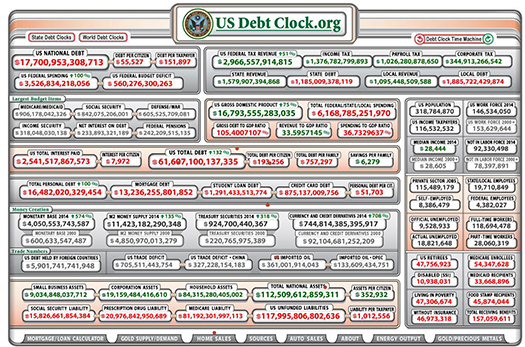
(Click here to see a larger version of this image.)
Part II: The Current Stock Market Type Is Bull Quiet
As you know, I look at the Market SQN® score for the daily percent changes in the S&P 500 Index over 200, 100, 50 and 25 days. For our purposes, the S&P 500 Index defines the market. On August 29th, the Market SQN® scores for the 200 and 100 day periods was Bull. The Market SQN for 50 and 25 days was both neutral. Since the sort term averages were neutral, this suggests that most of the change was to due poor performance 100 and 200 days ago.
The S&P 500 closed out August, however, with a bang when five of the last seven trading days reached all-time closing highs. So we had five new closing highs in June, two in July and another five in August. In 2014, there have been 32 new high closes. Right now we have a 100 day range change of 8.18 percent.
Market volatility remains in the quiet range.
The charts below include a weekly chart of the S&P 500 over the last year, the Market SQN® score for 100 days, and the percent volatility.
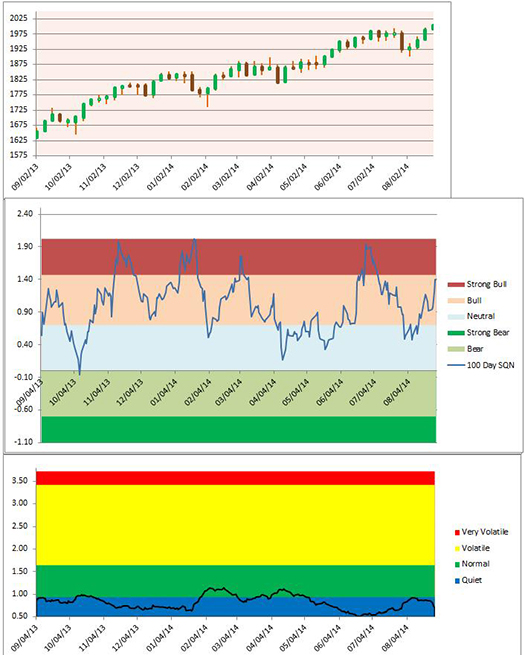
The market right now is providing us with a schooling in sideways quiet and quiet bear conditions. It looks like it could crash, we have 1-2 months where it’s difficult to make money and then the S&P 500 makes more new all-time closing highs. In the meantime, investment advisory services are screaming doom and gloom.
Below is a chart of the weekly changes in the three major US Indices. All three indices are up for the year, but not by a lot. In the first half of the year, we now have 32 record high closes with 5 of them being in August. The S&P 500 is now up 8.39% on the year, while the NASDAQ 100 is up 13.66%. The DOW is only up 4.7% on the year. As I said last month, it wouldn’t surprise me if “they” added AAPL to the Dow sometime this year to make it a better performer.
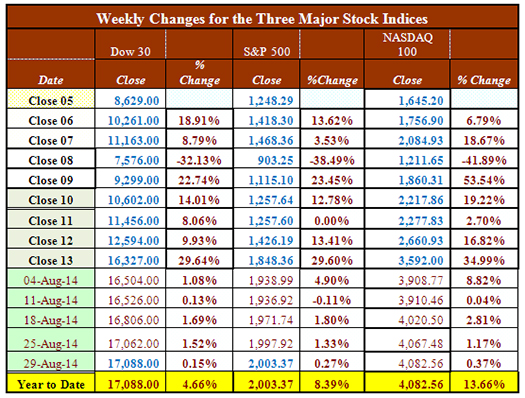
Part III: Our Four Star Inflation-Deflation Model
In the simplest terms, inflation means that stuff gets more expensive, and deflation means that stuff gets cheaper. There’s a correlation between the inflation rate and market levels, so the inflation rate can help traders understand big-picture processes.
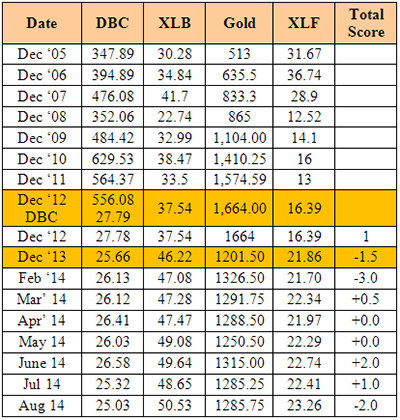
This data is up to date through August 30th. Looking back over the most recent two-month and six-month periods provides the current month’s score, given in the table below.
Month |
DBC2 |
DBC6 |
XLB2 |
XLB6 |
Gold2 |
Gold6 |
XLF2 |
XLF6 |
Total Score |
|
Lower |
Lower |
Higher |
Higher |
Lower |
Lower |
Higher |
Higher |
|
Jun 14 |
|
-1 |
|
+1 |
|
-1 |
|
-1 |
-2.0 |
We are back into deflationary statistics.
Part IV: Tracking the Dollar
The U.S. Dollar continues its up-move. We had lows in May of around 79 and it’s now around 82.6 I’m not sure what is happening, but there is the threat of a financial war against Russia and the BRIC countries which are, in turn, are threatening the dollar. It looks like the US is winning that one right now.
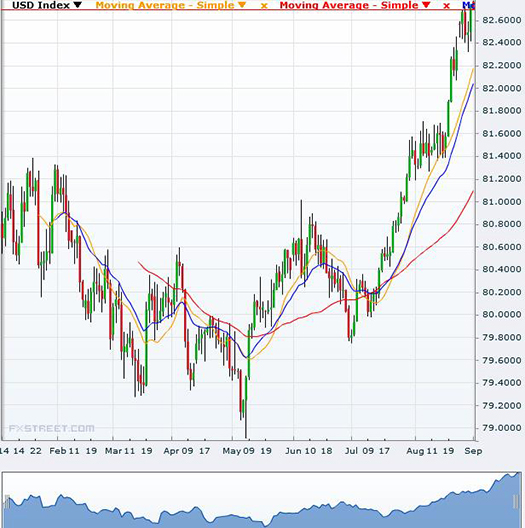
We are going to Germany in September to teach three Peak Performance workshops, so according to Tharp’s law (i.e., the dollar goes down when Van is using another currency), the second half of September could be a good month for the Euro (but please don’t try trading the dollar based on Tharp’s law, lol).
General Comments
Generally, I get a lot of email newsletters just to keep informed of what people are reading and lately, they are full of doom and gloom. The economic fundamentals are really bad, but the market continues to set new high and is in bull quiet territory. Enjoy the ride while you can.
Several newsletters have been giving away Jim Rickards book The Death of Money for free as part of new subscription promotions. What he says in that book makes total sense and is nothing I haven’t already pointed out. The economic situation is really bad and there will be lots of money to be made on the short side when the time comes. I think there will be plenty of warning for a major market downturn and that’s why I become very cautious when the market turns to quiet sideways. Often the market just moves back to bull quiet as it has been doing, but when it doesn’t, we’ll be ready.
I gave this prescription for the last few months and I will continue to include in in this update for at least the rest of the year.
This is my prescription for growth in the US economy. Politicians please read.
1) Kill deficit spending immediately, by stopping wars and spending on what we mistakenly call “defense.” We can’t afford to be the world peace keeper any more. We spend more than a trillion per year on “defense.”
2) Make sure no more deficit spending continues by passing a law calling for a re-election of new politicians any year the government cannot spend within their means. (I heard this first from Warren Buffet and borrowed it).
3) Right now the U.S. education system cannot compete with those of many other countries outside of the US except at the university level. And our best universities are filled with brilliant foreign students. Great, let’s accept the situation as it is and allow the brilliant foreign students who getting masters and Ph.D. degrees to immediately become U.S. citizens instead of forcing them to return to their own countries to use the skills we taught them abroad.
4) Give a $50,000 tax rebate to any US citizen getting a Ph.D. in the United States to help them pay for their education or their education loans.
5) Allow US companies to compete in the world in a big way by eliminating the tax on the foreign earnings of US citizen living abroad. Taxing foreign earnings of US citizens living in the US is fine, but not those who must live abroad to help our corporations grow and who must also pay foreign tax on their earnings.
6) Reduce Corporate Income tax from some of the highest levels in the world to competitive levels. Do this partially by not taxing foreign earnings from US corporations that are used to stimulate the economy. This would eliminate the US trade deficit fairly quickly.
7) I personally ordered a Tesla model S for delivery in October. Right now the government gives people a $7,500 credit for something that could totally eliminate the US dependency on foreign oil and dramatically reduce air pollution. Tesla has actually released their patents to the rest of the world. The model S met two of the criteria that I wanted in a car (great power—0-60 in 4.2 seconds) and great gas mileage (infinite). I didn’t think a Tesla met my third requirement (something I could have fun driving around the US). But it now looks like by the time I get my car they will have a ring of charging stations around the US and I will be able to drive around the US for FREE in 2015 and perhaps even do the same in many parts of Canada by the end of 2016. Let’s encourage the US to help Tesla (an American company) with their mission. Obviously, this recommendation is more a personal bias.
I’ve published this list for several months and items one and seven have gotten negative comments.
Until next month’s update, this is Van Tharp.
About the Author: Trading coach and author Van K. Tharp, Ph.D. is widely recognized for his best-selling books and outstanding Peak Performance Home Study Program—a highly regarded classic that is suitable for all levels of traders and investors. You can learn more about Van Tharp at www.vantharp.com. His newest book, Trading Beyond The Matrix, is available now at matrix.vantharp.com.
Workshops
Dr. Ken Long's Swing Trading Systems Workshop...Coming in October!
Learn to systematically trade ETFs and large caps to reap the benefits of their big numbers and start your path to mastering the craft of trading. How can you systematically make choices that will improve your chances in this challenging profession?
Ken Long teaches that you start with a strong understanding of:
* Your own psychology (Self Knowledge),
* The market (Market Knowledge) and
* How trading systems work (System Knowledge).
Ken has developed five robust swing systems out of this framework and will be teaching those systems this October. Click here to learn more about the basic format he will follow for each strategy. |
| September: Berlin, Germany |
| Sept 19-21 |
Peak Performance 101
with Van Tharp and co-instructor Janie Guill |
| Sept 23-26 |
Peak Performance 202
Sold Out. |
| Sept 28-30 |
Peak Performance 203
with Van Tharp and co-instructor Janie Guill |
| October |
| Oct 11-13 |
Forex Trading
with Gabriel Grammatidis |
| Oct 14-15 |
Live Forex Trading
with Gabriel Grammatidis |
| Oct 17-19 |
Swing Trading Systems
with Ken Long |
November |
| Oct 30-Nov 1 |
Peak Performance 101
with Van Tharp and co-instructors RJ Hixson and Janie Guill |
| Nov 3-6 |
Peak Performance 202
with Van Tharp and Libby Adams
and co-instructors RJ Hixson and Janie Guill |
| For Super Trader Only Events, click here. |
Combo Discounts available for all back-to-back workshops!
See our workshop page for details.
Trading Tip
August 2014 SQN® Report
By Van K. Tharp, Ph.D.
There are numerous ETFs that now track everything from countries, commodities, currencies and stock market indices to individual market sectors. ETFs provide a wonderfully easy way to discover what’s happening in the world markets. Consequently, I now apply a version of my System Quality Number® (SQN®) score to measure the relative performance of numerous markets in a world model.
The Market SQN score uses the daily percent change for input over a 100-day period. Typically, a Market SQN score over 1.47 is strongly bullish and a score below -0.7 is very weak. The following color codes help communicate the strengths and weaknesses of the ETFs in this report:
- Dark Green: ETFs with very strong SQN® 100 scores > 1.47
- Light Green: ETFs with strong SQN 100 scores (0.70 to 1.47).
- Yellow: ETFs with slightly positive Market SQN scores (0 to 0.70). These are Neutral/Sideways
- Brown: ETFs with slightly negative Market SQN scores (0 to -0.7).
- Red: Very weak ETFs that earn negative Market SQN scores (< -0.7).
This is basically the same ratings that we use for the Market SQN® Score. The world market model spreadsheet report below contains most currently available ETFs; including inverse funds, but excluding leveraged funds. In short, it covers the geographic world, the major asset classes, the equity market segments, the industrial sectors and the major currencies.
World Market Summary
Each month, we look at the equities markets across the globe by segment, region and sector. In the last month, Asia and the Americas have become even stronger than they were in July while Europe and the US don’t look as bad as they did last month.
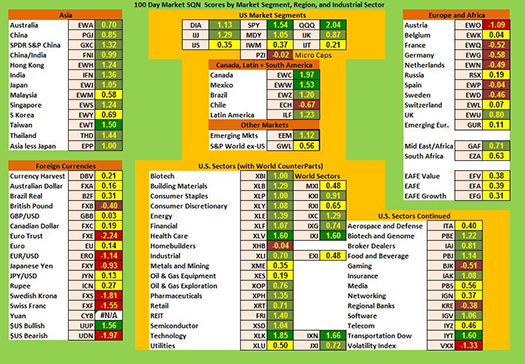
(Click here to see a larger version of this chart.)
Between August 9th and 29th, a lot changed. All US market segments are yellow to dark green except for the microcaps which are now brown (bear). The Americas continue doing well with Canada and Mexico being dark green, while Brazil and Latin America are light green. Chile is brown (bear).
Europe is not doing so well, but at least has improved since last month. The UK is light green as is the Middle-East and Africa. However, most countries in Europe are yellow (neutral) to brown (bear) with the exception of Austria which is currently red (strong bear).
Asia is in much better shape with most countries being green, only two are yellow (South Korea and Malaysia) and one dark green (Taiwan).
In the sectors, almost everything is light green. In fact, the only yellow ones are building materials (world) and consumer discretionary (world). There are a few dark green areas: health care, technology, and the Dow transports. And there are a few brown areas which are homebuilders, gaming, and regional banks. Volatility is still red (meaning there isn’t any).
Currencies this month are dominated by the US Dollar. And as a result, there are a few very weak currencies including the Euro, the Yen, the Swedish Krona, and the Swiss Franc. The Yuan, which has been very weak, hasn’t shown up in the model for the last two months due to a possible error in the CYB ETF data.
Commodities, Real Estate, Debt, Top and Bottom Lists
The next chart shows real estate, debt instruments, commodities and the top and bottom ETFs for the past 100 days.
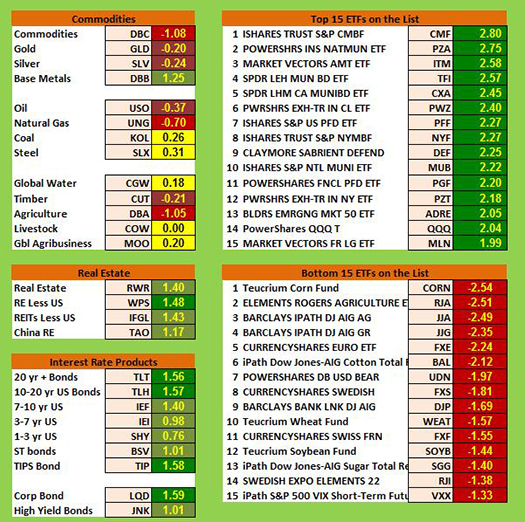
This month is much weaker in commodities as only base metals show up light green and there are no dark green areas. Red areas include commodities, agriculture, and natural gas.
US and Chinese real estate are both light green. All the interest rate sectors are positive, long term interest rates and inflation protected real estate being dark green while the shorter term instruments and junk bonds are now light green.
This month, the top 13 ETFs have SQN® scores above 2.0. Muni bonds are still among the strongest funds.
All of the weakest ETFs scored below -1.0 and six are below -2.0. The really weak ETFs tend to be agriculture related right now.
Summary
Now let’s look at our newest table which measures the percentage of ETFs in each of the strength categories.
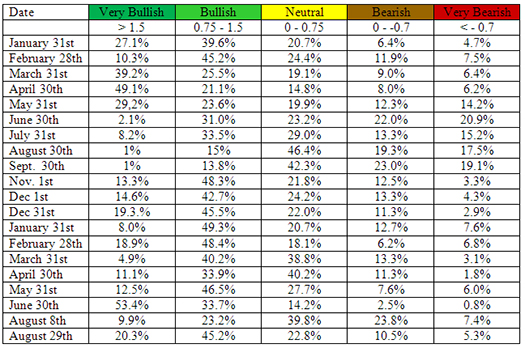
At the end of June, 87% of the ETFs we track were either bullish or very bullish, while only 3.3% were bearish or very bearish. On August 8th, 33.1% of the ETFs are either bullish or very bullish. This is down by about 54%. And at that time 31.2% were bearish or very bearish, up by 27.9%.
I’m showing you this to highlight the contrast. Now we have an up move. 65.5% are now bullish or very bullish while 15.8% are bearish or very bearish.
What's Going On?
The economic fundamentals are still terrible. The US stock market has moved back to Bull Quiet and set new high closes in five of the last seven days of the August. Be careful to base your actions upon what is happening, not what you think might happen.
Until the end of September, when I return from Europe, this is Van Tharp.
The markets always offer opportunities, but to capture those opportunities, you MUST know what you are doing. If you want to trade these markets, you need to approach them as a trader, not a long-term investor. We’d like to help you learn how to trade professionally because trying to navigate the markets without an education is hazardous to your wealth.
All the beliefs given in this update are my own. Though I find them useful, you may not. You can only trade your own beliefs about the markets.
Podcast
Michael Covel Interviews Van Tharp
Michael Covel interviews Van Tharp on his second visit to the Trend Following Radio show. Covel and Van Tharp discuss beliefs in the context of trading and investing; the moment of now, and the Navajo’s belief of a never-ending present; the belief examination paradigm; what “big money” means to Van Tharp; the idea of “trader jail”; fear of the unknown; the importance of sleep; and the difference between spirituality and religion.
Click here to listen.
Matrix Contest
Our Next Matrix Insight Contest has Begun!
 We want to hear about the one most profound insight that you got from reading Van's newest book, Trading Beyond the Matrix, and how it has impacted your life. We want to hear about the one most profound insight that you got from reading Van's newest book, Trading Beyond the Matrix, and how it has impacted your life.
We have updated some of the rules since the last contest, so please read them carefully before entering:
- Each essay should be around 1200 words.
- The ideal entries will focus more on a single transformative insight as opposed to “the whole book was transformational”.
- Dr. Tharp and the VTI team will pick the top 5 best entries from the submissions and our newsletter readers will vote to choose the top winner.
- The winner receives one free VTI foundation workshop; (*foundation workshops include the Peak Performance 101 workshop, How to Develop A Winning Trading System That Fits You, and the Blueprint for Trading Success workshop.) The winner may choose one of these workshops (valued at $2,995) or substitute any single VTI product priced at $795 (or below) of your choice.
- Over the duration of the contest, we will choose our favorite entries and publish them in our weekly newsletter, Tharp’s Thoughts. All entries appearing in the newsletter will receive a $50 coupon (increased from $20) which can be used on any VTI product or service.
If you would like to enter, send an email with your essay to [email protected].
If you haven't purchased Trading Beyond the Matrix yet, click here.
For more information about the contest, click here.
Missed the last contest? Click here to see all of the submissions which were picked to run in Tharp's Thoughts as well as the winning entry!
Ask Van...
Everything we do here at the Van Tharp Institute is focused on helping you improve as a trader and investor. Consequently, we love to get your feedback, both positive and negative!
Send comments or ask Van a question by clicking here.
Also, Click here to take our quick, 6-question survey.
Back to Top
Contact Us
Email us at [email protected]
The Van Tharp Institute does not support spamming in any way, shape or form. This is a subscription based newsletter.
To change your e-mail Address, e-mail us at [email protected].
To stop your subscription, click on the "unsubscribe" link at the bottom left-hand corner of this email.
How are we doing? Give us your feedback! Click here to take our quick survey.
Call us at: 800-385-4486 * 919-466-0043 * Fax 919-466-0408
SQN® and the System Quality Number® are registered trademarks of the Van Tharp Institute and the International Institute of Trading Mastery, Inc.
Be sure to check us out on Facebook and Twitter!
 
Back to Top |